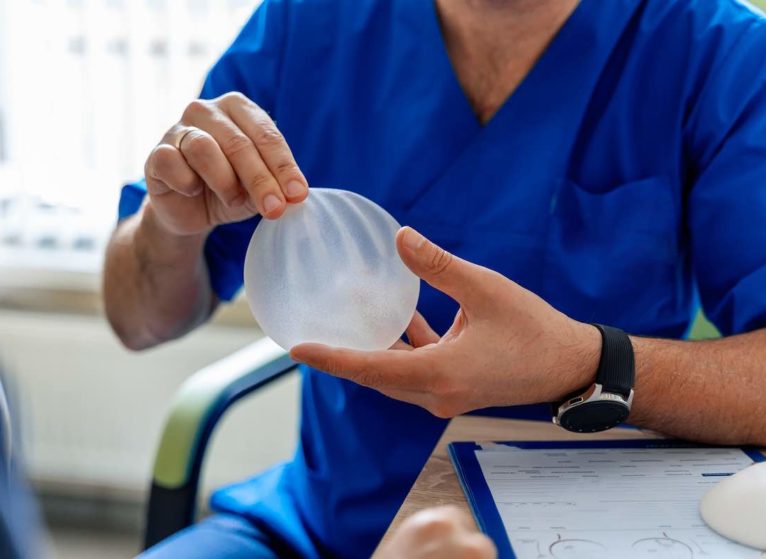The video stopped me from scrolling. It showed a breast implant that looked more like a small crystal ball than a fluid-filled sack. It didn’t give under pressure. When the doctor rolled it across a table, the hardened implant cracked and left behind a trail of white, plaster-like chunks.
What was wrong with that implant? Why did it get so hard? How often does this happen? Thanks to a suspect TikTok algorithm, I now had a whole lot of questions.
I turned to an expert: UVA Health plastic surgeon John Stranix, MD. He set the record straight on breast augmentation safety. And he explained how to identify some signs of breast implant problems that can happen over time.
Are Breast Implants Safe?
Right out of the gate, Stranix emphasizes that, yes, breast implants are safe. “We wouldn’t do an operation that is unsafe, or put an implant in that will have a negative impact on a person’s health,” he says. “Breast implants are very safe. This is a very straightforward procedure that provides someone with instant improvement that can make a big difference in their quality of life.”
This is good news for the approximately 400,000 women in the U.S. who get breast implants each year. However, as with any medical procedure, there are risks. Some of these complications can occur years after the implant placement.
Common Signs of Breast Implant Problems
If you have breast implants, it’s important to know how to identify potential problems. This way, your doctor can address them quickly. These are some of the more common complications and how to spot them.
Capsular Contracture
That hard, crusty implant I saw on TikTok? It was the product of capsular contracture. This condition is a buildup of scar tissue around an implant over time that causes the breast to harden. It can happen in one or both breasts.
“Essentially, whenever a foreign object is placed in the body, the body may wall it off with scar tissue,” says Stranix.
Some scar tissue buildup is normal. But when it becomes hard and dense, it leads to problems. Unfortunately, there’s no way to know who's at risk for this complication.
Stranix estimates that between 5-8% of people have this complication after receiving breast implants. “There are many theories why this happens in some people, but not others. However, the cause is unknown,” he says.
Signs of Capsular Contracture
Experts use a grading scale to determine the severity of capsular contracture. The condition may get worse over time.
- Grade I: Breast is soft and looks normal
- Grade II: Breast is firm, but looks normal
- Grade III: Breast is firm and looks abnormal, skin is tight
- Grade IV: Breast is hard, painful, and looks abnormal or out of position
How to Treat Capsular Contracture
For some, capsular contracture progresses so slowly that they won’t need treatment. For those with pain or concerns about looks, the only option is to remove the implant. “If someone is uncomfortable, then I would remove the implant. If possible, I would remove the capsule of scar tissue around the implant,” says Stranix. “Then we can place a new implant.”
If you are prone to capsular contraction, your surgeon may recommend different strategies to reduce the risk of it happening again. Unfortunately, the only way to be certain contracture will not recur is to remove implants permanently.
Implant Rupture
A lot of women worry about their breast implants rupturing, says Stranix. However, this happens to less than 1% of people each year.
Typically, implants rupture because of wear over time, especially if the implant is under the pectoralis major muscle in the chest. “This is a large muscle we use all the time. Repeated contractions of that muscle on the implant can lead to mechanical failure of its shell,” says Stranix.
Trauma is another common cause of rupture. This could be a fall or sports injury. But some also attribute implant rupture to mammograms.
Can a Mammogram Cause Rupture?
A traditional mammogram does put a lot of force on an implant, says Stranix. But there are workarounds for women with implants. “There is a procedure called Eklund views. The breast tissue is moved forward off the implant so it can be X-rayed without compromising the implant,” says Stranix.
Also, you may be a candidate for other cancer screening methods, such as a breast ultrasound or MRI. Be sure to tell your doctor and the person taking the mammogram that you have breast implants, so they can find the best option for you.
What not to do: delay cancer screening. “The CDC recommends mammography annually whether you have implants or not,” says Stranix. “The presence of implants does not delay the diagnosis of breast cancer.”
Signs of Implant Rupture
You think you’d notice if your implant ruptures. But you may not, especially if you have silicone implants.
Silicone implants have been the go-to for many years because they look and feel more natural. However, some still choose saline implants. Signs of rupture vary depending on the type of implant you have.
When a saline implant ruptures, the signs are more obvious.
- The body will absorb the saline
- The breast will deflate or look different
- Ripples or the edges of the implant may be visible
- You may have breast pain or soreness
When a silicone implant ruptures, the signs vary.
- Silicone may leak into the surrounding tissue of the breast and beyond
- The breast may swell or harden
- The breast may change in shape or look
- You may feel lumps in the breast
- You may have breast pain or soreness
Silicone is thicker and tends to hold its shape longer after a rupture. As a result, you might not notice it. If you have no other symptoms, doctors may catch the rupture by chance during a routine exam. You will need an imaging test like MRI or ultrasound to confirm the rupture.
How to Treat Implant Rupture
If a saline implant ruptures, a surgeon will need to remove the implant and replace it to restore the breast shape. However, if a silicone implant ruptures, you may be able to postpone removal depending on your symptoms. Should you need the implant removed, you may also choose not to have it replaced.
Considering Breast Implants?
A UVA Health plastic surgeon can walk you through the benefits and risks of breast augmentation.
More Signs of Breast Implant Problems
You may need a revision surgery or may have to remove an implant because of other common and not-so-common problems. Talk to your doctor if you notice these signs.
Changes In Appearance
Sometimes age and gravity cause an implant to shift or look different. The weight of an implant can weaken breast tissue, causing them to sag or bottom out. Or the skin surrounding the implant may thin and stretch to reveal the ripples and edges of an implant.
Unexplained Illness
A small percentage of people get something called breast implant illness (BII). Unfortunately, not a lot is known about this condition. Symptoms vary from one person to the next. Doctors make the diagnosis after ruling out all other possible conditions. Some of the signs of BII may include: chronic fatigue, joint pain, hair loss, and headache.
How Long Do Breast Implants Last?
I assumed breast implants were a one-and-done type of procedure. However, that’s not typically the case. “As a general rule, implants need replacing approximately every 10 years. But, not necessarily,” says Stranix. “Some have their implants for 20-40 years and are just fine.”
If they're in a good position and they’re not bothering you, whether it’s been 2 years or 20, Stranix says there’s no need to replace them unless you have signs of breast implant problems. “Basically, when it comes to replacement, it’s more about patient comfort and satisfaction rather than a set timeline,” he says.



Grateful for the informative article on signs of breast implant problems that can occur over time. It provides valuable insights for individuals with breast implants to be aware of potential complications and seek timely medical attention.
Glad you find it informative.